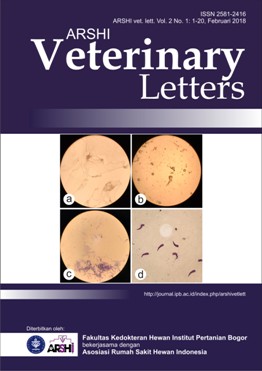Metode nephrosplenic entrapment reposition untuk penanganan kasus large colon displacement pada kuda
Abstract
Large colon displacement merupakan perpindahan posisi kolon menjadi ke arah kiri disebut left dorsal displacement of colon (LDDC), atau ke arah kanan disebut right dorsal displacement of colon (RDDC). Perpindahan ini menyebabkan kolik pada kuda. Palpasi per rektal pada kuda G. Galunggung menunjukkan adanya perubahan konsistensi dan perpindahan lokasi kolon sehingga dugaan utama adalah terjadinya large colon displacement. Palpasi per rektal daerah nephrosplenic menunjukkan limpa pindah ke arah caudal di dinding kiri abdomen. Hal ini menunjukkan bahwa kuda G. Galunggung mengalami LDDC. Reposisi mekanis metode nephrosplenic entrapment reposition menggunakan katrol dilakukan untuk mengembalikan posisi kolon yang terperangkap di antara ginjal dan limpa setelah kuda G. Galunggung dibius terlebih dahulu. Konfirmasi secara palpasi per rektal menunjukan bahwa metode tersebut berhasil mengembalikan posisi kolon pada kasus kuda G. Galunggung. Setelah 3 hari perlakuan, kuda makan dan minum secara normal, konsitensi feses normal, serta tidak terjadi kolik maupun ambruk.Downloads
References
Abanese V, Caldwell FJ. 2014. Left dorsal displacement of the large colon in the horse. Equine Veterinary Education. 26(2):107-111.
Hardy J, Minton M, Robertson JT, Beard WL, Beard LA. 2000. Nephrosplenic entrapment in the horse: a retrospective study of 174 cases. Equine Vet. J. 32: 95-97.
Moore JN. 2005. Making Sense of Large Colon Displacements in Horses. VetFolio. http://www.vetfolio.com/internal-medicine/making-sense-of-large-colon-displacements-in-horses
Thal D. 2016. Left Dorsal Displacement of Colon with Nephrosplenic. http://www.horsidevetguide.com
White NA. 2006. Equine Colic. AAEP.Ann.Conv. 52:109-174.
Copyright (c) 2018 CC-BY-SA

This work is licensed under a Creative Commons Attribution-ShareAlike 4.0 International License.
Authors who publish with this journal agree to the following terms:
1. Authors retain copyright and grant the journal right of first publication with the work simultaneously licensed under a Creative Commons Attribution License that allows others to share the work with an acknowledgement of the work's authorship and initial publication in this journal.
2. Authors are able to enter into separate, additional contractual arrangements for the non-exclusive distribution of the journal's published version of the work (e.g., post it to an institutional repository or publish it in a book), with an acknowledgement of its initial publication in this journal.
3. Authors are permitted and encouraged to post their work online (e.g., in institutional repositories or on their website) prior to and during the submission process, as it can lead to productive exchanges, as well as earlier and greater citation of published work (See The Effect of Open Access).


.jpg)















